Earthquake and Tsunami of Northeastern Japan Case Study 2022
VerifiedAdded on 2022/09/25
|11
|1911
|20
AI Summary
Contribute Materials
Your contribution can guide someone’s learning journey. Share your
documents today.
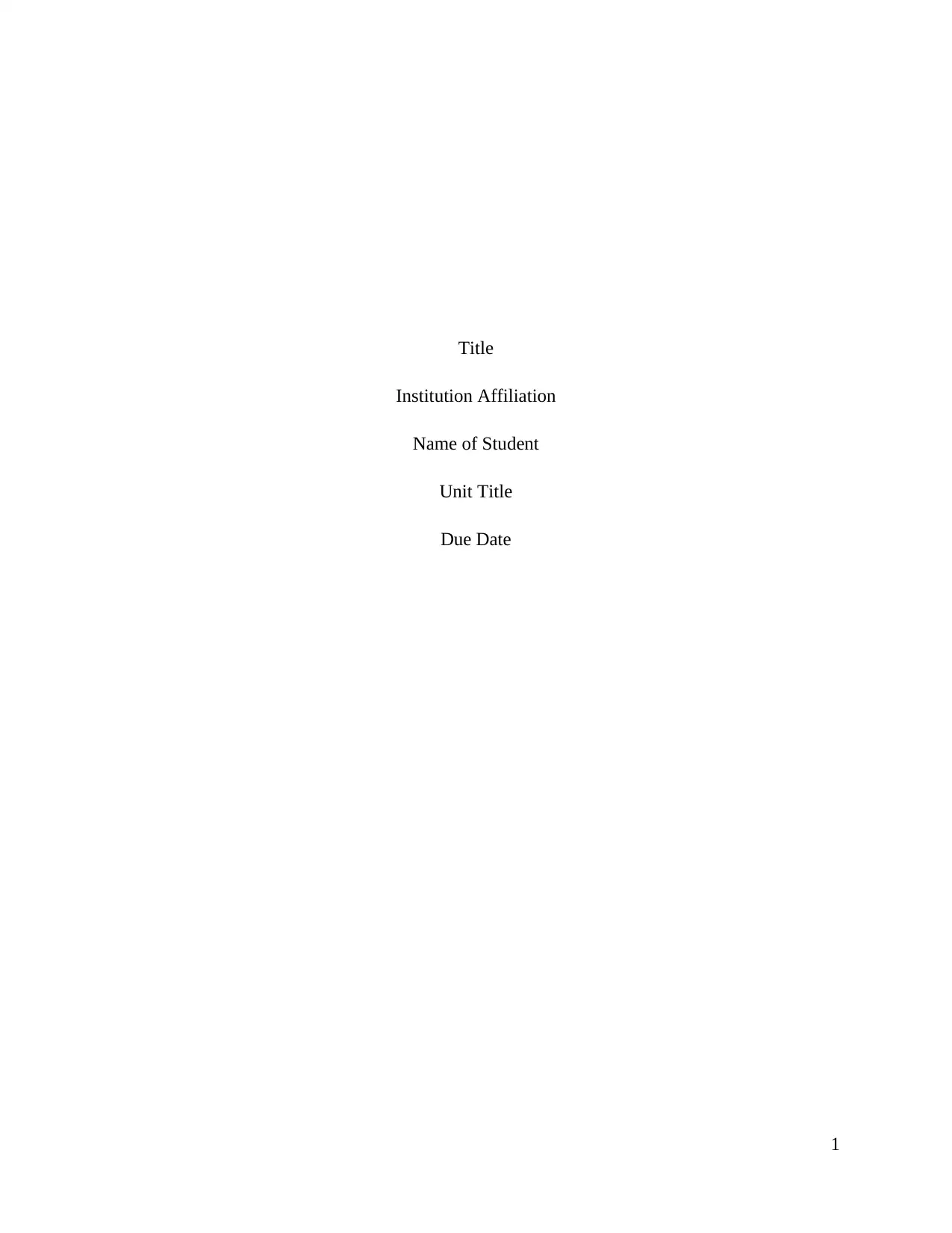
1
Title
Institution Affiliation
Name of Student
Unit Title
Due Date
Title
Institution Affiliation
Name of Student
Unit Title
Due Date
Secure Best Marks with AI Grader
Need help grading? Try our AI Grader for instant feedback on your assignments.
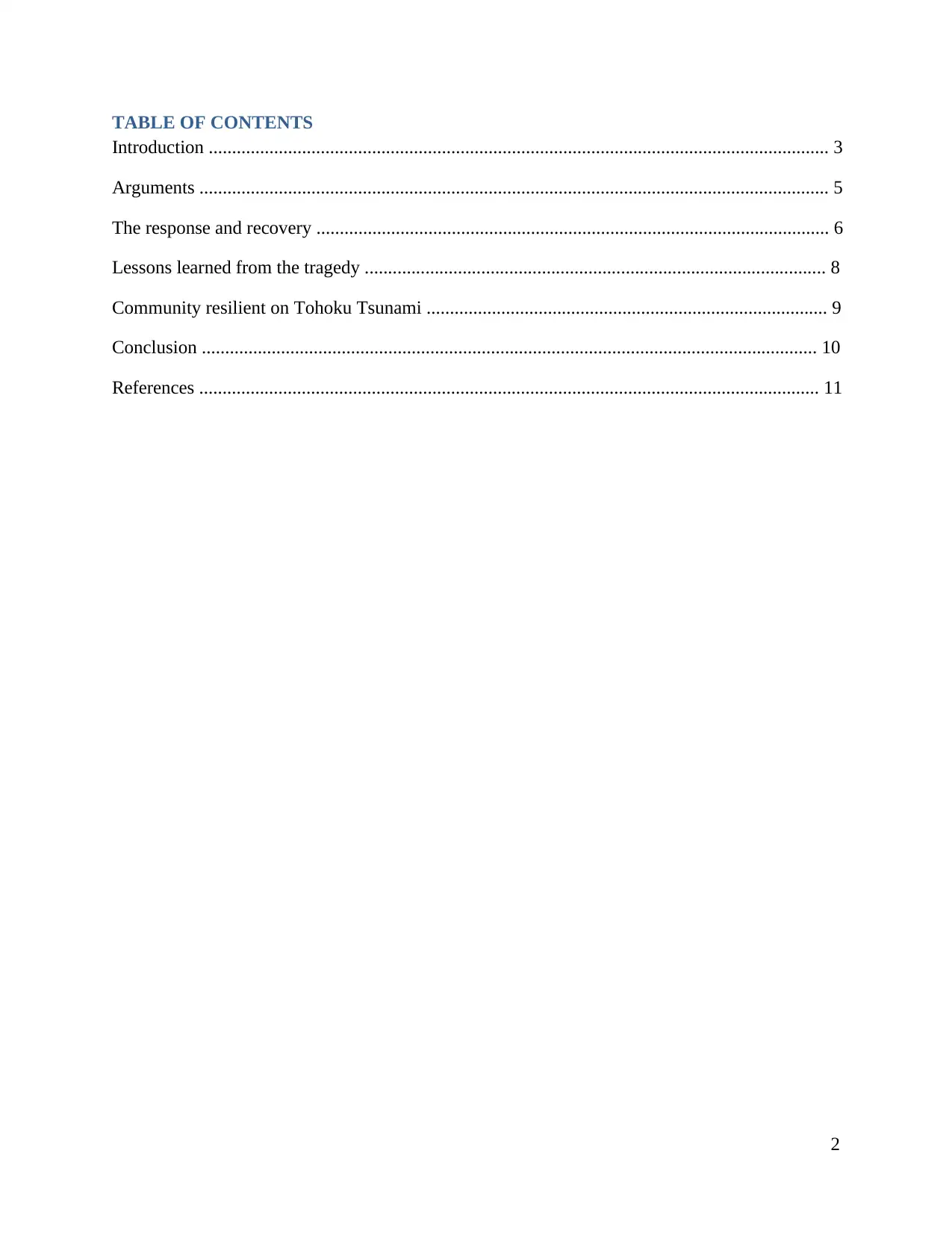
2
TABLE OF CONTENTS
Introduction ..................................................................................................................................... 3
Arguments ....................................................................................................................................... 5
The response and recovery .............................................................................................................. 6
Lessons learned from the tragedy ................................................................................................... 8
Community resilient on Tohoku Tsunami ...................................................................................... 9
Conclusion .................................................................................................................................... 10
References ..................................................................................................................................... 11
TABLE OF CONTENTS
Introduction ..................................................................................................................................... 3
Arguments ....................................................................................................................................... 5
The response and recovery .............................................................................................................. 6
Lessons learned from the tragedy ................................................................................................... 8
Community resilient on Tohoku Tsunami ...................................................................................... 9
Conclusion .................................................................................................................................... 10
References ..................................................................................................................................... 11
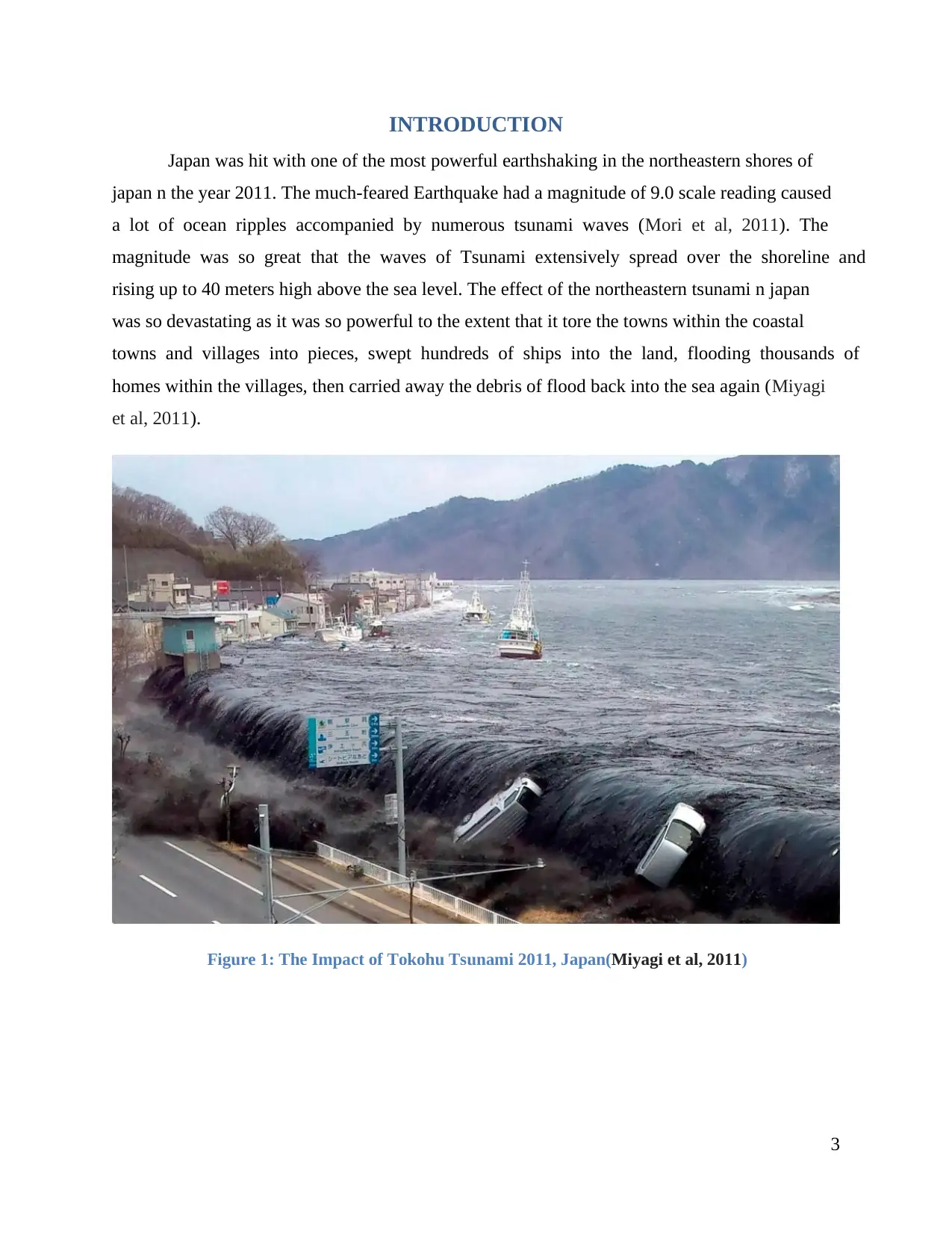
3
INTRODUCTION
Japan was hit with one of the most powerful earthshaking in the northeastern shores of
japan n the year 2011. The much-feared Earthquake had a magnitude of 9.0 scale reading caused
a lot of ocean ripples accompanied by numerous tsunami waves (Mori et al, 2011). The
magnitude was so great that the waves of Tsunami extensively spread over the shoreline and
rising up to 40 meters high above the sea level. The effect of the northeastern tsunami n japan
was so devastating as it was so powerful to the extent that it tore the towns within the coastal
towns and villages into pieces, swept hundreds of ships into the land, flooding thousands of
homes within the villages, then carried away the debris of flood back into the sea again (Miyagi
et al, 2011).
Figure 1: The Impact of Tokohu Tsunami 2011, Japan(Miyagi et al, 2011)
INTRODUCTION
Japan was hit with one of the most powerful earthshaking in the northeastern shores of
japan n the year 2011. The much-feared Earthquake had a magnitude of 9.0 scale reading caused
a lot of ocean ripples accompanied by numerous tsunami waves (Mori et al, 2011). The
magnitude was so great that the waves of Tsunami extensively spread over the shoreline and
rising up to 40 meters high above the sea level. The effect of the northeastern tsunami n japan
was so devastating as it was so powerful to the extent that it tore the towns within the coastal
towns and villages into pieces, swept hundreds of ships into the land, flooding thousands of
homes within the villages, then carried away the debris of flood back into the sea again (Miyagi
et al, 2011).
Figure 1: The Impact of Tokohu Tsunami 2011, Japan(Miyagi et al, 2011)
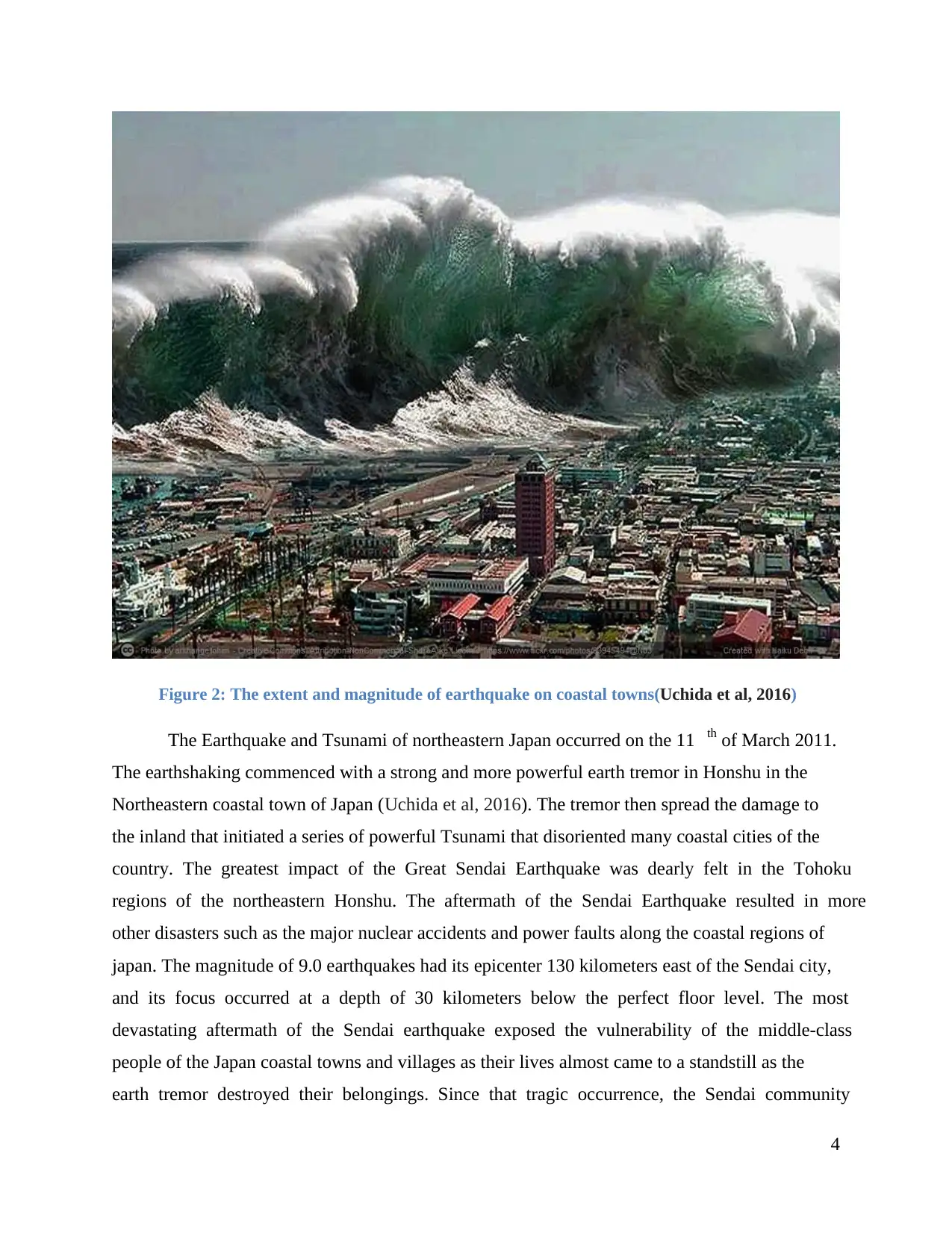
4
Figure 2: The extent and magnitude of earthquake on coastal towns(Uchida et al, 2016)
The Earthquake and Tsunami of northeastern Japan occurred on the 11 th of March 2011.
The earthshaking commenced with a strong and more powerful earth tremor in Honshu in the
Northeastern coastal town of Japan (Uchida et al, 2016). The tremor then spread the damage to
the inland that initiated a series of powerful Tsunami that disoriented many coastal cities of the
country. The greatest impact of the Great Sendai Earthquake was dearly felt in the Tohoku
regions of the northeastern Honshu. The aftermath of the Sendai Earthquake resulted in more
other disasters such as the major nuclear accidents and power faults along the coastal regions of
japan. The magnitude of 9.0 earthquakes had its epicenter 130 kilometers east of the Sendai city,
and its focus occurred at a depth of 30 kilometers below the perfect floor level. The most
devastating aftermath of the Sendai earthquake exposed the vulnerability of the middle-class
people of the Japan coastal towns and villages as their lives almost came to a standstill as the
earth tremor destroyed their belongings. Since that tragic occurrence, the Sendai community
Figure 2: The extent and magnitude of earthquake on coastal towns(Uchida et al, 2016)
The Earthquake and Tsunami of northeastern Japan occurred on the 11 th of March 2011.
The earthshaking commenced with a strong and more powerful earth tremor in Honshu in the
Northeastern coastal town of Japan (Uchida et al, 2016). The tremor then spread the damage to
the inland that initiated a series of powerful Tsunami that disoriented many coastal cities of the
country. The greatest impact of the Great Sendai Earthquake was dearly felt in the Tohoku
regions of the northeastern Honshu. The aftermath of the Sendai Earthquake resulted in more
other disasters such as the major nuclear accidents and power faults along the coastal regions of
japan. The magnitude of 9.0 earthquakes had its epicenter 130 kilometers east of the Sendai city,
and its focus occurred at a depth of 30 kilometers below the perfect floor level. The most
devastating aftermath of the Sendai earthquake exposed the vulnerability of the middle-class
people of the Japan coastal towns and villages as their lives almost came to a standstill as the
earth tremor destroyed their belongings. Since that tragic occurrence, the Sendai community
Secure Best Marks with AI Grader
Need help grading? Try our AI Grader for instant feedback on your assignments.
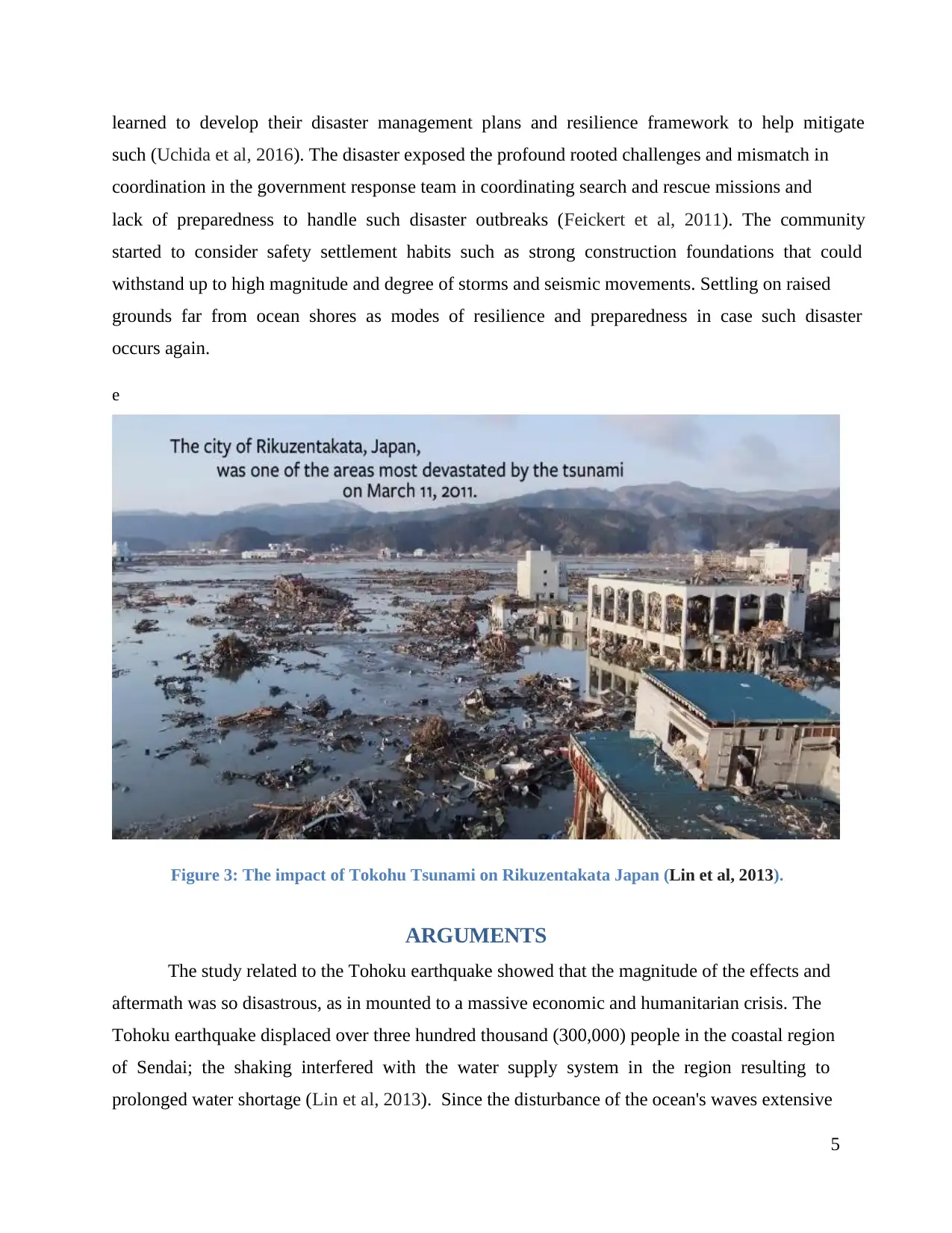
5
learned to develop their disaster management plans and resilience framework to help mitigate
such (Uchida et al, 2016). The disaster exposed the profound rooted challenges and mismatch in
coordination in the government response team in coordinating search and rescue missions and
lack of preparedness to handle such disaster outbreaks (Feickert et al, 2011). The community
started to consider safety settlement habits such as strong construction foundations that could
withstand up to high magnitude and degree of storms and seismic movements. Settling on raised
grounds far from ocean shores as modes of resilience and preparedness in case such disaster
occurs again.
e
Figure 3: The impact of Tokohu Tsunami on Rikuzentakata Japan (Lin et al, 2013).
ARGUMENTS
The study related to the Tohoku earthquake showed that the magnitude of the effects and
aftermath was so disastrous, as in mounted to a massive economic and humanitarian crisis. The
Tohoku earthquake displaced over three hundred thousand (300,000) people in the coastal region
of Sendai; the shaking interfered with the water supply system in the region resulting to
prolonged water shortage (Lin et al, 2013). Since the disturbance of the ocean's waves extensive
learned to develop their disaster management plans and resilience framework to help mitigate
such (Uchida et al, 2016). The disaster exposed the profound rooted challenges and mismatch in
coordination in the government response team in coordinating search and rescue missions and
lack of preparedness to handle such disaster outbreaks (Feickert et al, 2011). The community
started to consider safety settlement habits such as strong construction foundations that could
withstand up to high magnitude and degree of storms and seismic movements. Settling on raised
grounds far from ocean shores as modes of resilience and preparedness in case such disaster
occurs again.
e
Figure 3: The impact of Tokohu Tsunami on Rikuzentakata Japan (Lin et al, 2013).
ARGUMENTS
The study related to the Tohoku earthquake showed that the magnitude of the effects and
aftermath was so disastrous, as in mounted to a massive economic and humanitarian crisis. The
Tohoku earthquake displaced over three hundred thousand (300,000) people in the coastal region
of Sendai; the shaking interfered with the water supply system in the region resulting to
prolonged water shortage (Lin et al, 2013). Since the disturbance of the ocean's waves extensive
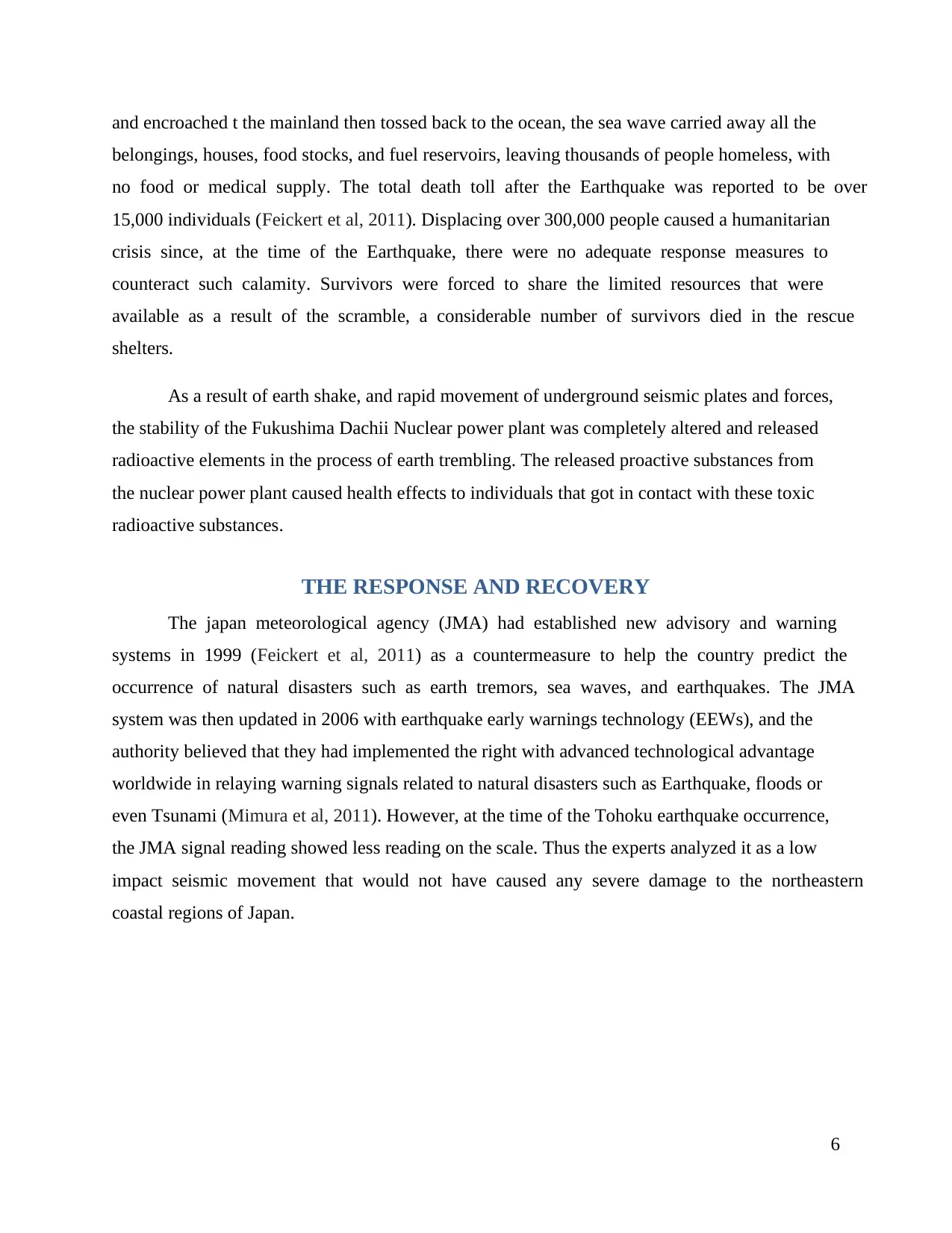
6
and encroached t the mainland then tossed back to the ocean, the sea wave carried away all the
belongings, houses, food stocks, and fuel reservoirs, leaving thousands of people homeless, with
no food or medical supply. The total death toll after the Earthquake was reported to be over
15,000 individuals (Feickert et al, 2011). Displacing over 300,000 people caused a humanitarian
crisis since, at the time of the Earthquake, there were no adequate response measures to
counteract such calamity. Survivors were forced to share the limited resources that were
available as a result of the scramble, a considerable number of survivors died in the rescue
shelters.
As a result of earth shake, and rapid movement of underground seismic plates and forces,
the stability of the Fukushima Dachii Nuclear power plant was completely altered and released
radioactive elements in the process of earth trembling. The released proactive substances from
the nuclear power plant caused health effects to individuals that got in contact with these toxic
radioactive substances.
THE RESPONSE AND RECOVERY
The japan meteorological agency (JMA) had established new advisory and warning
systems in 1999 (Feickert et al, 2011) as a countermeasure to help the country predict the
occurrence of natural disasters such as earth tremors, sea waves, and earthquakes. The JMA
system was then updated in 2006 with earthquake early warnings technology (EEWs), and the
authority believed that they had implemented the right with advanced technological advantage
worldwide in relaying warning signals related to natural disasters such as Earthquake, floods or
even Tsunami (Mimura et al, 2011). However, at the time of the Tohoku earthquake occurrence,
the JMA signal reading showed less reading on the scale. Thus the experts analyzed it as a low
impact seismic movement that would not have caused any severe damage to the northeastern
coastal regions of Japan.
and encroached t the mainland then tossed back to the ocean, the sea wave carried away all the
belongings, houses, food stocks, and fuel reservoirs, leaving thousands of people homeless, with
no food or medical supply. The total death toll after the Earthquake was reported to be over
15,000 individuals (Feickert et al, 2011). Displacing over 300,000 people caused a humanitarian
crisis since, at the time of the Earthquake, there were no adequate response measures to
counteract such calamity. Survivors were forced to share the limited resources that were
available as a result of the scramble, a considerable number of survivors died in the rescue
shelters.
As a result of earth shake, and rapid movement of underground seismic plates and forces,
the stability of the Fukushima Dachii Nuclear power plant was completely altered and released
radioactive elements in the process of earth trembling. The released proactive substances from
the nuclear power plant caused health effects to individuals that got in contact with these toxic
radioactive substances.
THE RESPONSE AND RECOVERY
The japan meteorological agency (JMA) had established new advisory and warning
systems in 1999 (Feickert et al, 2011) as a countermeasure to help the country predict the
occurrence of natural disasters such as earth tremors, sea waves, and earthquakes. The JMA
system was then updated in 2006 with earthquake early warnings technology (EEWs), and the
authority believed that they had implemented the right with advanced technological advantage
worldwide in relaying warning signals related to natural disasters such as Earthquake, floods or
even Tsunami (Mimura et al, 2011). However, at the time of the Tohoku earthquake occurrence,
the JMA signal reading showed less reading on the scale. Thus the experts analyzed it as a low
impact seismic movement that would not have caused any severe damage to the northeastern
coastal regions of Japan.
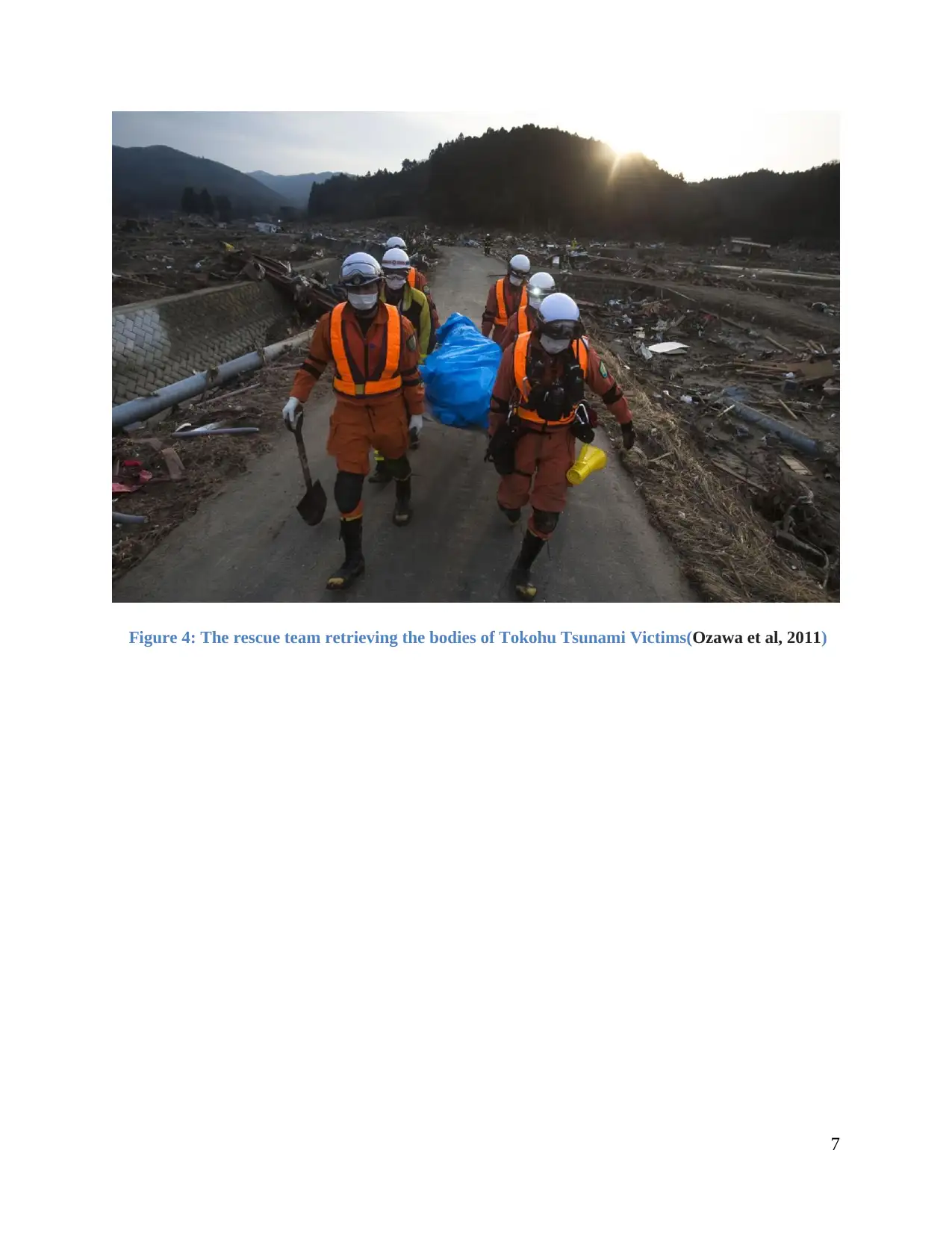
7
Figure 4: The rescue team retrieving the bodies of Tokohu Tsunami Victims(Ozawa et al, 2011)
Figure 4: The rescue team retrieving the bodies of Tokohu Tsunami Victims(Ozawa et al, 2011)
Paraphrase This Document
Need a fresh take? Get an instant paraphrase of this document with our AI Paraphraser
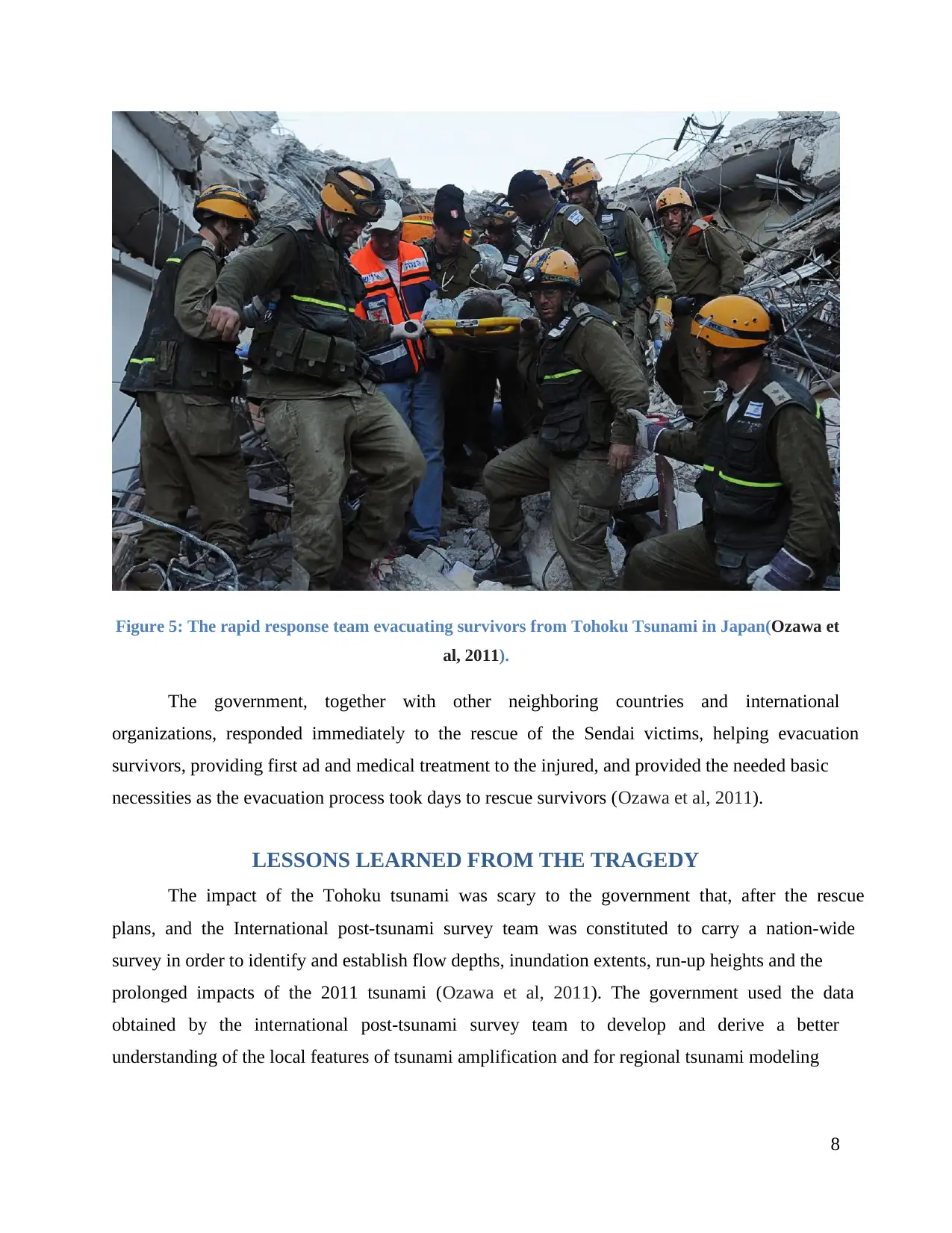
8
Figure 5: The rapid response team evacuating survivors from Tohoku Tsunami in Japan(Ozawa et
al, 2011).
The government, together with other neighboring countries and international
organizations, responded immediately to the rescue of the Sendai victims, helping evacuation
survivors, providing first ad and medical treatment to the injured, and provided the needed basic
necessities as the evacuation process took days to rescue survivors (Ozawa et al, 2011).
LESSONS LEARNED FROM THE TRAGEDY
The impact of the Tohoku tsunami was scary to the government that, after the rescue
plans, and the International post-tsunami survey team was constituted to carry a nation-wide
survey in order to identify and establish flow depths, inundation extents, run-up heights and the
prolonged impacts of the 2011 tsunami (Ozawa et al, 2011). The government used the data
obtained by the international post-tsunami survey team to develop and derive a better
understanding of the local features of tsunami amplification and for regional tsunami modeling
Figure 5: The rapid response team evacuating survivors from Tohoku Tsunami in Japan(Ozawa et
al, 2011).
The government, together with other neighboring countries and international
organizations, responded immediately to the rescue of the Sendai victims, helping evacuation
survivors, providing first ad and medical treatment to the injured, and provided the needed basic
necessities as the evacuation process took days to rescue survivors (Ozawa et al, 2011).
LESSONS LEARNED FROM THE TRAGEDY
The impact of the Tohoku tsunami was scary to the government that, after the rescue
plans, and the International post-tsunami survey team was constituted to carry a nation-wide
survey in order to identify and establish flow depths, inundation extents, run-up heights and the
prolonged impacts of the 2011 tsunami (Ozawa et al, 2011). The government used the data
obtained by the international post-tsunami survey team to develop and derive a better
understanding of the local features of tsunami amplification and for regional tsunami modeling
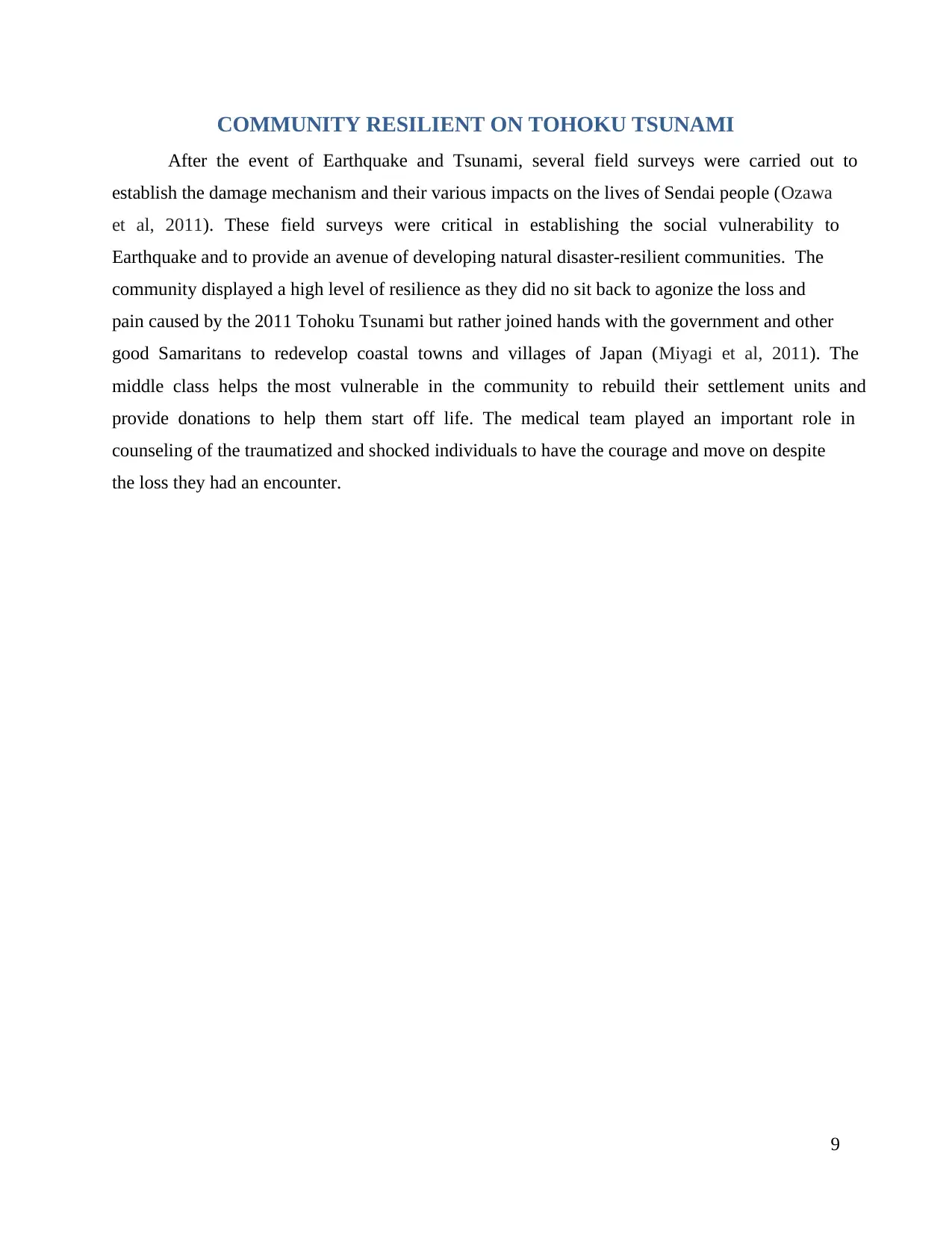
9
COMMUNITY RESILIENT ON TOHOKU TSUNAMI
After the event of Earthquake and Tsunami, several field surveys were carried out to
establish the damage mechanism and their various impacts on the lives of Sendai people (Ozawa
et al, 2011). These field surveys were critical in establishing the social vulnerability to
Earthquake and to provide an avenue of developing natural disaster-resilient communities. The
community displayed a high level of resilience as they did no sit back to agonize the loss and
pain caused by the 2011 Tohoku Tsunami but rather joined hands with the government and other
good Samaritans to redevelop coastal towns and villages of Japan (Miyagi et al, 2011). The
middle class helps the most vulnerable in the community to rebuild their settlement units and
provide donations to help them start off life. The medical team played an important role in
counseling of the traumatized and shocked individuals to have the courage and move on despite
the loss they had an encounter.
COMMUNITY RESILIENT ON TOHOKU TSUNAMI
After the event of Earthquake and Tsunami, several field surveys were carried out to
establish the damage mechanism and their various impacts on the lives of Sendai people (Ozawa
et al, 2011). These field surveys were critical in establishing the social vulnerability to
Earthquake and to provide an avenue of developing natural disaster-resilient communities. The
community displayed a high level of resilience as they did no sit back to agonize the loss and
pain caused by the 2011 Tohoku Tsunami but rather joined hands with the government and other
good Samaritans to redevelop coastal towns and villages of Japan (Miyagi et al, 2011). The
middle class helps the most vulnerable in the community to rebuild their settlement units and
provide donations to help them start off life. The medical team played an important role in
counseling of the traumatized and shocked individuals to have the courage and move on despite
the loss they had an encounter.
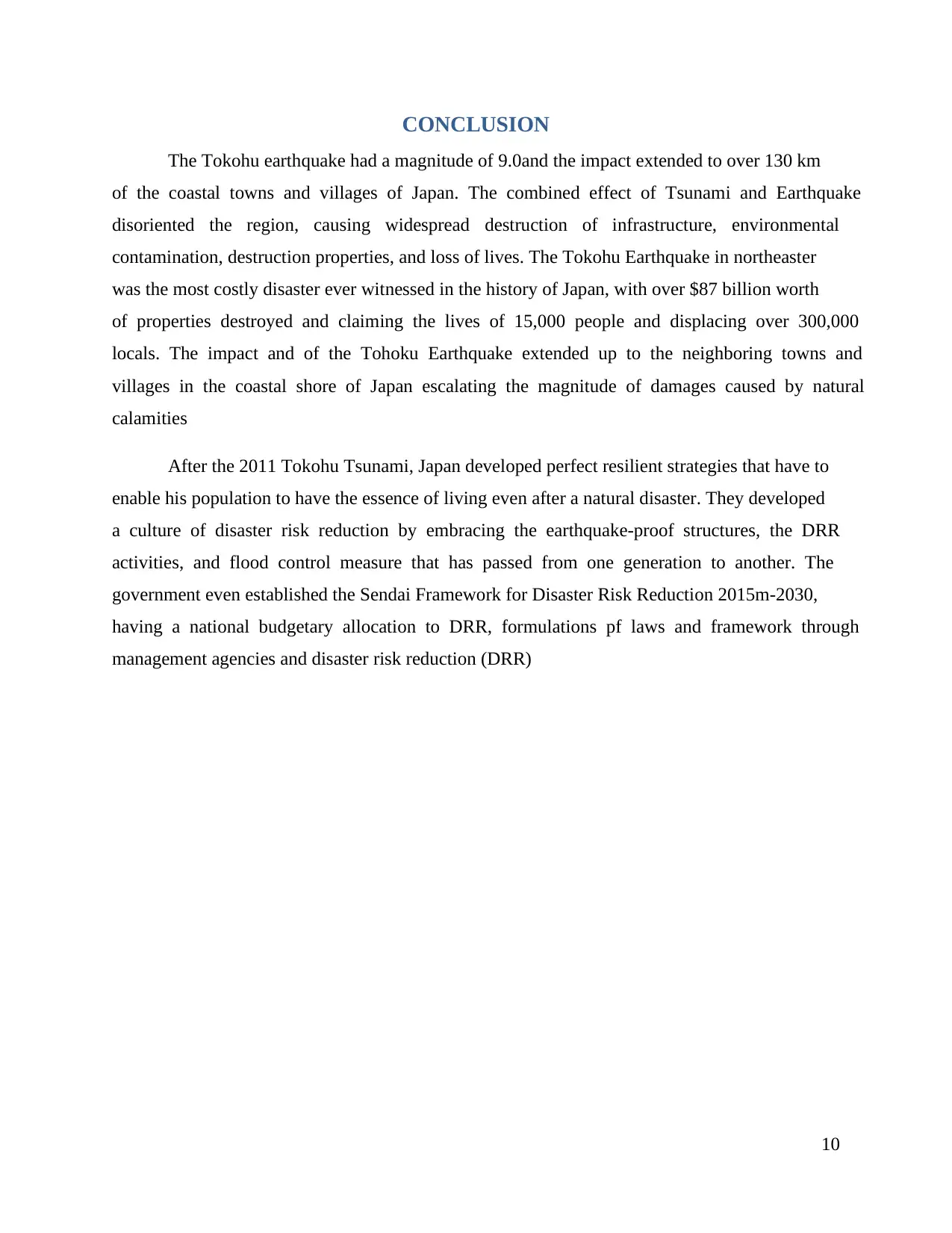
10
CONCLUSION
The Tokohu earthquake had a magnitude of 9.0and the impact extended to over 130 km
of the coastal towns and villages of Japan. The combined effect of Tsunami and Earthquake
disoriented the region, causing widespread destruction of infrastructure, environmental
contamination, destruction properties, and loss of lives. The Tokohu Earthquake in northeaster
was the most costly disaster ever witnessed in the history of Japan, with over $87 billion worth
of properties destroyed and claiming the lives of 15,000 people and displacing over 300,000
locals. The impact and of the Tohoku Earthquake extended up to the neighboring towns and
villages in the coastal shore of Japan escalating the magnitude of damages caused by natural
calamities
After the 2011 Tokohu Tsunami, Japan developed perfect resilient strategies that have to
enable his population to have the essence of living even after a natural disaster. They developed
a culture of disaster risk reduction by embracing the earthquake-proof structures, the DRR
activities, and flood control measure that has passed from one generation to another. The
government even established the Sendai Framework for Disaster Risk Reduction 2015m-2030,
having a national budgetary allocation to DRR, formulations pf laws and framework through
management agencies and disaster risk reduction (DRR)
CONCLUSION
The Tokohu earthquake had a magnitude of 9.0and the impact extended to over 130 km
of the coastal towns and villages of Japan. The combined effect of Tsunami and Earthquake
disoriented the region, causing widespread destruction of infrastructure, environmental
contamination, destruction properties, and loss of lives. The Tokohu Earthquake in northeaster
was the most costly disaster ever witnessed in the history of Japan, with over $87 billion worth
of properties destroyed and claiming the lives of 15,000 people and displacing over 300,000
locals. The impact and of the Tohoku Earthquake extended up to the neighboring towns and
villages in the coastal shore of Japan escalating the magnitude of damages caused by natural
calamities
After the 2011 Tokohu Tsunami, Japan developed perfect resilient strategies that have to
enable his population to have the essence of living even after a natural disaster. They developed
a culture of disaster risk reduction by embracing the earthquake-proof structures, the DRR
activities, and flood control measure that has passed from one generation to another. The
government even established the Sendai Framework for Disaster Risk Reduction 2015m-2030,
having a national budgetary allocation to DRR, formulations pf laws and framework through
management agencies and disaster risk reduction (DRR)
Secure Best Marks with AI Grader
Need help grading? Try our AI Grader for instant feedback on your assignments.
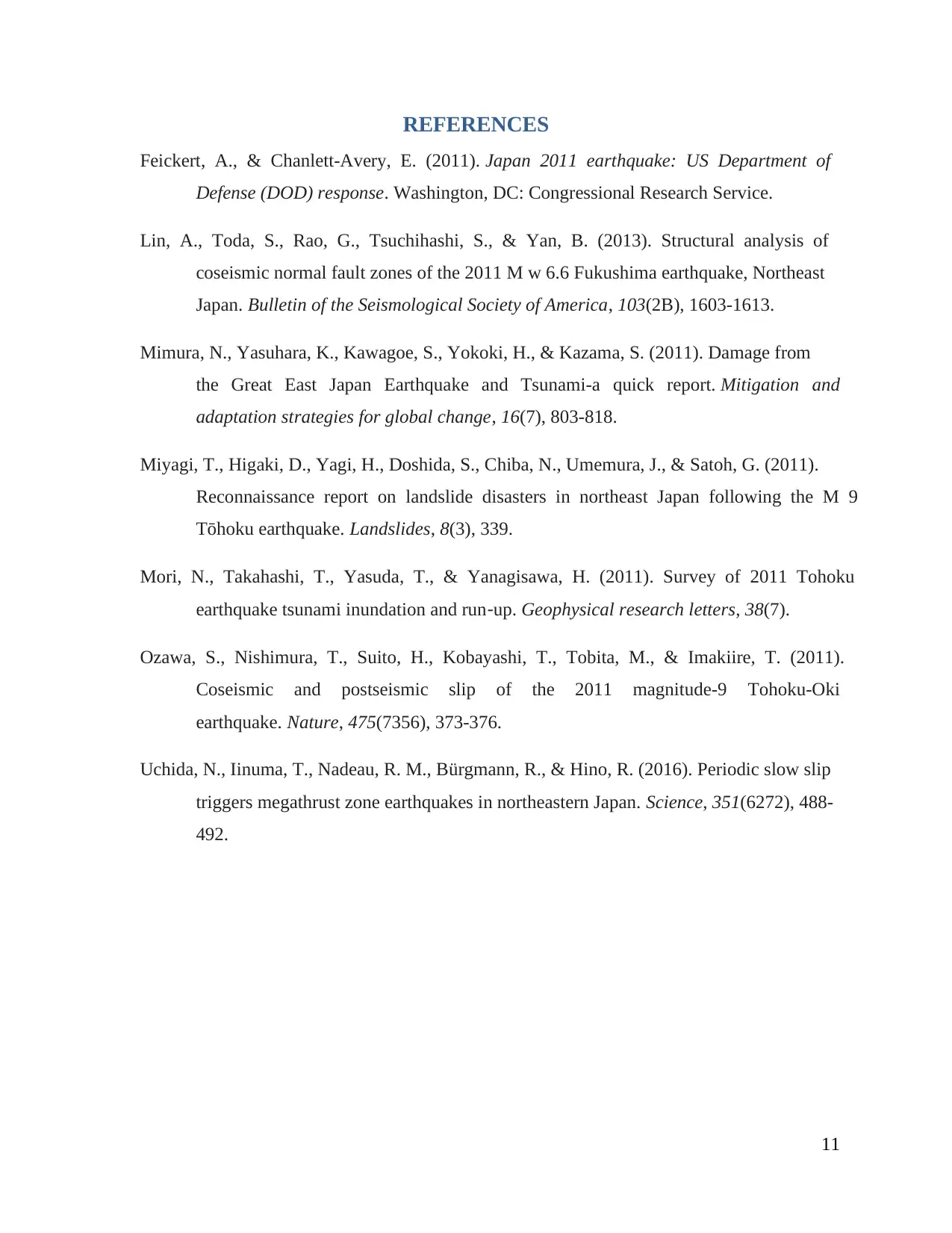
11
REFERENCES
Feickert, A., & Chanlett-Avery, E. (2011). Japan 2011 earthquake: US Department of
Defense (DOD) response. Washington, DC: Congressional Research Service.
Lin, A., Toda, S., Rao, G., Tsuchihashi, S., & Yan, B. (2013). Structural analysis of
coseismic normal fault zones of the 2011 M w 6.6 Fukushima earthquake, Northeast
Japan. Bulletin of the Seismological Society of America, 103(2B), 1603-1613.
Mimura, N., Yasuhara, K., Kawagoe, S., Yokoki, H., & Kazama, S. (2011). Damage from
the Great East Japan Earthquake and Tsunami-a quick report. Mitigation and
adaptation strategies for global change, 16(7), 803-818.
Miyagi, T., Higaki, D., Yagi, H., Doshida, S., Chiba, N., Umemura, J., & Satoh, G. (2011).
Reconnaissance report on landslide disasters in northeast Japan following the M 9
Tōhoku earthquake. Landslides, 8(3), 339.
Mori, N., Takahashi, T., Yasuda, T., & Yanagisawa, H. (2011). Survey of 2011 Tohoku
earthquake tsunami inundation and run‐up. Geophysical research letters, 38(7).
Ozawa, S., Nishimura, T., Suito, H., Kobayashi, T., Tobita, M., & Imakiire, T. (2011).
Coseismic and postseismic slip of the 2011 magnitude-9 Tohoku-Oki
earthquake. Nature, 475(7356), 373-376.
Uchida, N., Iinuma, T., Nadeau, R. M., Bürgmann, R., & Hino, R. (2016). Periodic slow slip
triggers megathrust zone earthquakes in northeastern Japan. Science, 351(6272), 488-
492.
REFERENCES
Feickert, A., & Chanlett-Avery, E. (2011). Japan 2011 earthquake: US Department of
Defense (DOD) response. Washington, DC: Congressional Research Service.
Lin, A., Toda, S., Rao, G., Tsuchihashi, S., & Yan, B. (2013). Structural analysis of
coseismic normal fault zones of the 2011 M w 6.6 Fukushima earthquake, Northeast
Japan. Bulletin of the Seismological Society of America, 103(2B), 1603-1613.
Mimura, N., Yasuhara, K., Kawagoe, S., Yokoki, H., & Kazama, S. (2011). Damage from
the Great East Japan Earthquake and Tsunami-a quick report. Mitigation and
adaptation strategies for global change, 16(7), 803-818.
Miyagi, T., Higaki, D., Yagi, H., Doshida, S., Chiba, N., Umemura, J., & Satoh, G. (2011).
Reconnaissance report on landslide disasters in northeast Japan following the M 9
Tōhoku earthquake. Landslides, 8(3), 339.
Mori, N., Takahashi, T., Yasuda, T., & Yanagisawa, H. (2011). Survey of 2011 Tohoku
earthquake tsunami inundation and run‐up. Geophysical research letters, 38(7).
Ozawa, S., Nishimura, T., Suito, H., Kobayashi, T., Tobita, M., & Imakiire, T. (2011).
Coseismic and postseismic slip of the 2011 magnitude-9 Tohoku-Oki
earthquake. Nature, 475(7356), 373-376.
Uchida, N., Iinuma, T., Nadeau, R. M., Bürgmann, R., & Hino, R. (2016). Periodic slow slip
triggers megathrust zone earthquakes in northeastern Japan. Science, 351(6272), 488-
492.
1 out of 11
Your All-in-One AI-Powered Toolkit for Academic Success.
+13062052269
info@desklib.com
Available 24*7 on WhatsApp / Email
![[object Object]](/_next/static/media/star-bottom.7253800d.svg)
Unlock your academic potential
© 2024 | Zucol Services PVT LTD | All rights reserved.

